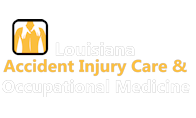Audiometric Hearing Testing
Louisiana Accident Injury Care & Occupational Medicine provides customized hearing testing, tailored to your organization’s needs.
Under OSHA Standard 1910.95: Occupational noise exposure, OSHA requires employers to provide a Hearing Conservation Program for employees who are exposed to work-related noise equivalent to 85 dBA over an eight-hour TWA. At 90 dBA, OSHA mandates that employees be fitted and trained to wear hearing protection.
The OSHA standard proscribes the readings from an audiometric test and the amount of variation from the initial baseline test to a subsequent annual exam that signify when the employee has experienced a standard threshold shift, or a significant, permanent hearing loss. A standard threshold shift is a hearing loss of 10 dBA or greater in either ear as determined by the average of the readings at the frequencies 2000, 3000, and 4000 hertz (a measure of frequency or pitch). An occupational health provider is likely to also be concerned with a hearing loss below 10 dBA, which may indicate a temporary threshold shift, a temporary hearing loss that may become permanent without an intervention.
If it is determined the hearing loss is not caused by work, the employee should be referred to the primary care physician for follow-up treatment.
Employers are required to provide audiometric testing at baseline and annual exams, hearing protection, and training at no cost to the employee. Hearing conservation programs are designed to prevent initial hearing loss, preserve and protect remaining hearing once any hearing loss occurs, and give employees the training they need to protect themselves.13
The preeminent need to protect employees from hazardous occupational noise is well-served by audiometric and otoscopic examinations, but employers should not overlook important measures that can reduce risk, including:
- When feasible, eliminate any sources of hazardous noise exposure.
- Reduce the loudness and intensity of sound (measured in decibels) and its frequency or pitch (measured in hertz). However, don’t just lock onto one measurement; there is a need to take all physical properties of sound into consideration.
- Use engineering controls to modify or replace noisy equipment or to make changes in the transmission path of the noise.
- Implement administrative controls. An example would be to change an employee’s work schedule to avoid exposure to excessive noise.
- Provide and train employees in the use of personal protective equipment (PPE) to safeguard the ears.
- Provide education to help employees understand the need to protect themselves from damaging noise, both on and off the job.

